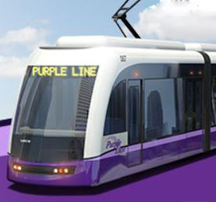Bus Rapid Transit Report Shows Practical Way Forward:
Use Existing Highway Lanes - Start Now With Metro's Priority Corridors
Press release issued April 23, 2012
The just-completed report of Montgomery County's bus rapid transit task force identifies a practical direction for better bus service in Montgomery County, the county's transit advocates say.
The Action Committee for Transit, a grassroots group with over 500 dues-paying members in the county, pointed to three clear take-home messages from the report:
- The only way to create an effective, affordable rapid bus network is to use existing roadway lanes more efficiently by reserving them for bus-only traffic.
- BRT cannot succeed without also building the light rail Purple Line as a high-capacity east-west connection inside the Beltway.
- A BRT network must be built in phases.
As a first step towards the BRT network, ACT repeated its call for full implementation of Metro's Priority Corridor Initiative on the county's most heavily traveled bus corridors. This program speeds buses by relocating stops, extending green lights to let buses through, and designating bus-only lanes on a few short sections of roadway. The initiative has significantly improved bus service in the District of Columbia, but the Montgomery County Dept. of Transportation refuses to allow any modification of existing roadways that would cause buses to move faster than cars.
“We can start right now with the Priority Corridor Initiative, which costs the county nothing,” said ACT president Tina Slater. “Let's give commuters a chance to see the benefits of bus priorities right away. Then we will be in a much better position to decide on the large investment that a full BRT network will require.”
By designating a few bus lanes now, ACT vice-president Ben Ross pointed out, transportation engineers will be able to work out the bugs that are inevitable when roadways are redesigned. Putting high-speed bus lanes in the center of roadways, which the task force recommends for the portions of the county outside the Beltway, requires limits on left turns and other changes in highway operations. Ross noted that the residential streets in these areas, unlike most places where BRT has been implemented, are not laid out in a densely connected grid. “BRT offers us a tremendous opportunity to convert ugly traffic sewers into walkable city streets, but we need to learn how to do it right,” he said.
Slater, who is also a member of the county task force, pointed out that a 1996 county study of BRT on US 29 was abandoned after it drew opposition from neighbors who feared BRT would get in the way of pedestrians and local traffic. “We can't afford to have that happen again,” she said. “Successful bus lanes will build the community support that the BRT initiative needs.”

